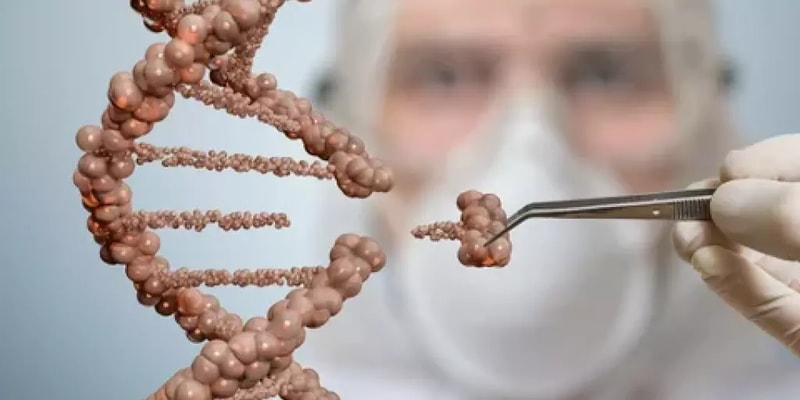24 Questions
What staining method is used to obtain Q-banding in chromosomes?
Quinacrine stain
Which type of bands are obtained when chromosomes are stained with Giemsa after trypsin digestion?
Light and dark bands
What is the main characteristic of R-bands on chromosomes?
Guanine-cytosine-rich regions
Which type of staining binds to constitutive heterochromatin in chromosomes?
Giemsa stain
What is the function of T-banding in chromosome visualization?
Stains telomeres
What was the purpose of the classification proposed at the conference in Denver (1960) regarding chromosomes?
To name the chromosome pairs alphabetically
Which banding technique involves gentle trypsin treatment of chromosomes followed by staining with Giemsa?
G-banding
Who introduced the first banding technique for chromosomes using quinacrine and obtained Q-bands?
Prof. Casperson
Which banding technique was introduced at the Paris Conference in 1971 to identify individual chromosomes?
Q-banding
What is the position of G-bands primarily rich in?
AT-rich regions
How is each chromosome arm initially divided for the identification of bands in G-banding?
Divided into regions
Which banding technique resulted in the production of the first human banded chromosomes by using quinacrine?
Q-banding
In a male somatic cell, how many total chromosomes are present?
46
What is the term for chromosomes classified based on the position of their centromere?
Metacentric
Which arm of a chromosome is referred to as the 'p arm'?
Shorter arm above centromere
What is the primary criteria used for arranging chromosomes in order?
Size of chromosomes
Which type of chromosome has a centromere positioned at one end resulting in a very small short arm?
Acrocentric
What characterizes chromosomes with a secondary constriction containing genes for organizing the nucleolus?
Presence of chromosomal satellite
What is the correct term for human somatic cells containing two sets of chromosomes?
Diploid
How many pairs of homologous chromosomes are present in human somatic cells?
22 pairs
Which scientist introduced the term 'chromosome' derived from Greek words for 'colour' and 'body'?
Waldeyer
What is the correct chromosome number in human somatic cells as determined by Tjio and Levan in 1956?
46
How many pairs of autosomes are present in male human somatic cells?
22 pairs
Which type of cells contain one set of chromosomes?
Gametes
Study Notes
Chromosome Banding Techniques
- Q-banding in chromosomes is obtained using quinacrine staining method.
- G-bands are obtained when chromosomes are stained with Giemsa after trypsin digestion.
- R-bands on chromosomes are characterized by being rich in GC bases and have a reverse pattern compared to G-bands.
Types of Bands and Staining
- C-banding is a staining technique that binds to constitutive heterochromatin in chromosomes.
- T-banding is a technique used for chromosome visualization, especially for telomeres.
History of Chromosome Classification
- The Denver Conference in 1960 introduced a classification system for chromosomes.
- The Paris Conference in 1971 introduced a banding technique to identify individual chromosomes.
Chromosome Structure and Characteristics
- G-bands are primarily rich in AT bases and are found in the heterochromatic regions of chromosomes.
- Each chromosome arm is initially divided into regions, then bands, for identification in G-banding.
- Acrocentric chromosomes have a centromere positioned at one end, resulting in a very small short arm.
- Chromosomes with a secondary constriction containing genes for organizing the nucleolus are characterized by nucleolar organizing regions (NORs).
Cell Biology and Chromosome Number
- A male somatic cell contains 46 total chromosomes.
- Diploid cells, like human somatic cells, contain two sets of chromosomes.
- There are 23 pairs of homologous chromosomes in human somatic cells.
History of Chromosome Research
- The term 'chromosome' was introduced by Heinrich Wilhelm Gottfried von Waldeyer-Hartz, derived from Greek words for 'colour' and 'body'.
- The correct chromosome number in human somatic cells is 46, as determined by Tjio and Levan in 1956.
- Male human somatic cells contain 22 pairs of autosomes.
Learn about karyotype, a representation of all chromosomes in a diploid cell. Explore the classification of chromosomes into different groups based on morphology and the nomenclature system established in the 1960s.
Make Your Own Quizzes and Flashcards
Convert your notes into interactive study material.




